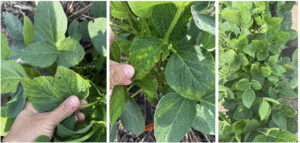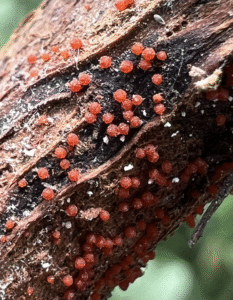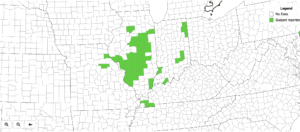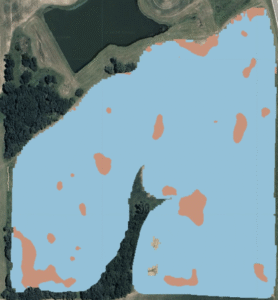Red Crown Rot Symptoms Emerging in Illinois Soybeans
Symptoms of Red Crown Rot (RCR), caused by the soilborne fungus Calonectria ilicicola, have begun to appear in our 2025 field trials at Illinois farms in Madison and Macoupin counties with a known history of the disease (Figure 1). Similar observations are being reported by colleagues in Kentucky and Indiana, indicating regional disease activity is underway.

Figure 1. Early foliar symptoms of red crown rot in soybean observed in Madison and Macoupin counties on July 17, 2025. Symptoms begin as light green to yellow blotches between the veins (interveinal chlorosis) and may progress to interveinal necrosis as the disease advances.
Recognizing Red Crown Rot
RCR affects roots, stems, and leaves of soybean plants.
Foliar symptoms begin as small, light green to yellow blotches between the veins that expand into interveinal necrosis (Figure 2), a pattern that can resemble sudden death syndrome (SDS). Leaves may die prematurely and often remain attached to the plant.

Figure 2. Advanced foliar symptoms of red crown rot in soybean, showing pronounced interveinal necrosis.
Stem symptoms typically start with a reddish discoloration at the base of the stem. Under humid conditions, this area may become covered with white fungal growth and reddish-brown spore-producing structures (Figure 3).

Figure 3. Red perithecia of Calonectria ilicicola, the causal agent of red crown rot, forming on the surface of an infected soybean stem. These spore-producing structures develop under humid conditions later in the season and are a diagnostic feature of the disease.
Roots are frequently severely rotted, and infected plants are often easily pulled from the soil.
For the typical timing of symptom development, refer to Figure 4.

Figure 4. Timing of red crown rot (RCR) symptom development in soybean, relative to crop growth stages
Confirming Red Crown Rot: Send Samples for Diagnosis
Because foliar symptoms of RCR—particularly interveinal chlorosis and necrosis—can closely resemble other soybean diseases like SDS, accurate diagnosis is critical. Visual symptoms alone are not always enough to distinguish between these diseases, especially in early stages or in fields with overlapping disease pressure.
A key diagnostic feature of RCR is the presence of red perithecia (spore-producing structures) on the lower stem. However, these structures only form under the right weather conditions, typically late in the season, and may disappear after rainfall, making them easy to miss during scouting.
If you suspect red crown rot in your fields, we strongly recommend submitting samples to the University of Illinois Plant Clinic for confirmation.
Submission instructions and forms are available at:
https://extension.illinois.edu/plant-clinic
Track Historical Risk Areas
Counties where RCR has been confirmed in the past are more likely to see the disease again this season, especially under favorable conditions. You can view a map of previously confirmed counties through the Crop Protection Network .

Figure 5. Counties with past confirmed reports of red crown rot of soybean.
Help Advance Red Crown Rot Research: Field Locations Needed
As part of our ongoing efforts to improve early detection and management of RCR, our team at the University of Illinois is conducting a remote sensing research project aimed at identifying and monitoring RCR in soybean fields using drone and satellite imagery.
This project is supported by the Illinois Soybean Association, and its goal is to develop practical, data-driven tools that can help Illinois farmers detect and manage RCR more effectively. The tool could be used to guide targeted fungicide applications, improving efficiency and reducing unnecessary costs.
To support this work, we are currently seeking on-farm field locations with a known history of red crown rot in Illinois. Fields with active or previous outbreaks are especially valuable for validating our detection models and improving disease prediction tools.
If you are a grower or consultant managing a field affected by RCR and are willing to collaborate, please contact us. All information shared with our team will be kept strictly confidential and used solely for research purposes.
Contact:
Dr. Boris Camiletti
Email: bxc@illinois.edu

Figure 6. Example of a remote sensing classification map showing areas predicted to be affected by red crown rot (highlighted in orange) overlaid on a soybean field. This tool is being developed to guide targeted fungicide applications and improve disease management efficiency.





